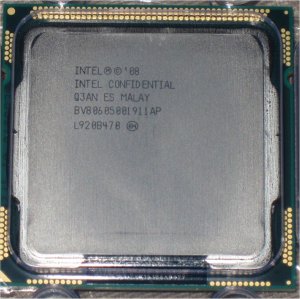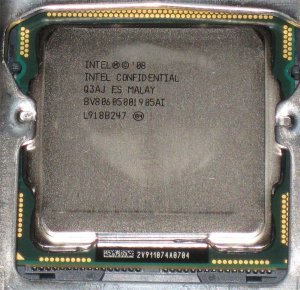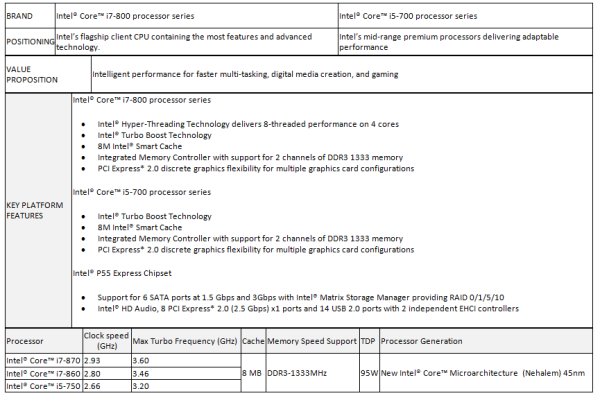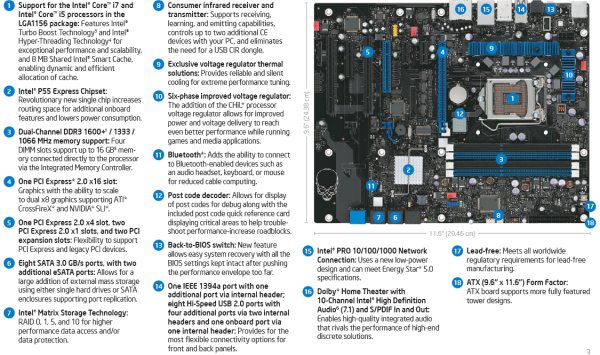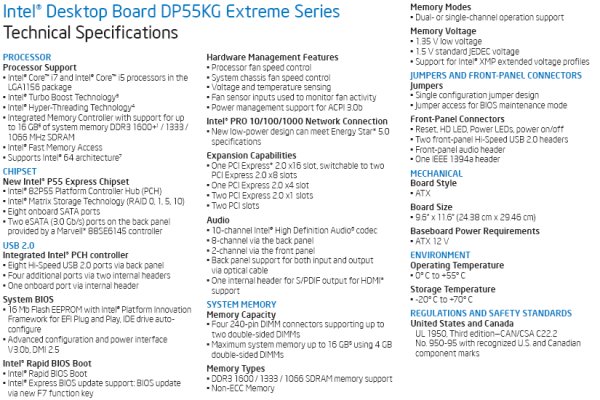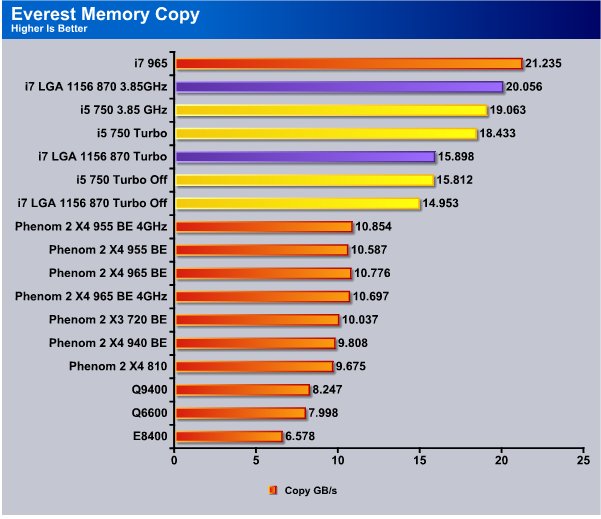The new LGA 1156 Core i5/i7 CPU’s are here! Lets take them for a test drive and see how they run with and without Turbo Boost, and OCed until they scream for mercy.
INTRODUCTION
We’ve been hearing a lot about the new Core i5/i7 CPU’s, and generally we like to reserve our opinion until the test results are in. We’ve benched the Core i5 750 and Core i7 870 extensively. We’ve added a bevvy of tests to our benchmarking routine and Core i5/i7 LGA 1156 is looking pretty good.
The P55 chipset is not based on the traditional 3 chip (NB/SB/CPU) design and the NB and SB have been replaced with the PCH or Platform Controller Hub. The new design moves a lot of the PCI-E lanes on to the CPU Die and the rest are handled by the PCH. Most of the traditional NB/SB functions are handled by the CPU/PCH on the new P55 platform. As time progresses you can expect to see more and more functions moved onto the CPU die itself.
While many are resistant to change and have the “it was working why did they fix it” attitude they need to realize this is going to be a vital evolution in computing. It might seem like a small change on the surface but with on DIE PCI-E and moving to a 2 chip solution you reduce latencies, you also reduce the amount of coordination between chips. Instead of the CPU handling the communication between NB and SB and trying to make sense of signals coming from two different directions it either handles the I/O itself or the PCH feeds it the information.
Sound interesting? Combined with a more mainstream priced platform and great overclocking, the LGA 1156 Core i5/i7 platform will not only fill the bill for performance but it’ll be a little easier on your bank account.
These are the i5 750 (left) and i7 870 (right) we received to evaluate, notice that they say Intel confidential so you’ll just have to take our word for it as to which one is which. There’s nothing like the smell of a confidential CPU ready to roast.
Specifications
| Intel Core i7 & Core i5 Processor Series Key Features & Specifications |
||||||
| Intel Core i7 965 Extreme Edition |
Intel Core i7 940 | Intel Core i7 920 | Intel Core i7 870 (LGA 1156) | Intel Core i750 (LGA 1156) | ||
| Clock Speed | 3.2 GHz | 2.93 GHz | 2.66 GHz | 2.93GHz Max Turbo 3.6GHz | 2.66 GHz Max Turbo 3.2GHz | |
| CPU Socket | 1366 | 1366 | 1366 | 1156 | 1156 | |
| Shared L3 Cache | 8 MB | 8 MB | 8 MB | 8 MB | 8 MB | |
| Memory | DDR3 Triple Channel | DDR3 Triple Channel | DDR3 Triple Channel | DDR3 Dual Channel | DDR3 Dual Channel | |
| TDP | 130 Watts | 130 Watts | 130 Watts | 95 Watts | 95 Watts | |
| Overspeed Protection | Removed | Enforced | Enforced | Enforced | Enforced | |
| Architecture | Intel 45 nm Nehalem |
Intel 45 nm Nehalem |
Intel 45 nm Nehalem |
New Intel 45 nm Nehalem |
New Intel 45 nm Nehalem |
|
| Quad Core | Yes | Yes | Yes | Yes | Yes | |
| Key Platform Features |
|
|||||
LGA 1156 Specific Specifications
We are limited to 600 pixel wide images in our current format so if you would like a larger readable image please click on the specifications and you’ll be able to read the individual specifications for the whole LGA 1156 lineup.
CPU PICTURES
The Intel Confidential markings on the CPU won’t do you much good for CPU identification, but we like to show the parts we have in house for testing. This is a shot of the LGA 1156 i7 870.
Then we have a shot of the LGA 1156 i5 750, and the two biggest differences between the 870 and the 750 are that the 750 isn’t Hyperthreaded, and it runs at 2.66GHz instead of 2.93GHz like the 870. They are the same family of processors, but the 750 is just the little brother.
The back of the CPU is covered in pin receptor pads and cache chips galore. We included a higher resolution image for those that want a closer look.
Intel Extreme DP55KG Motherboard
Like with all the new Intel CPU’s we’ve reviewed we get a motherboard in the review kit. In this case, a rather nice Intel Extreme DP55KG LGA 1156 board. The complete specifications on the board haven’t been published yet, but we will give you the information we have on hand, and of course some drool shots.
Specifications

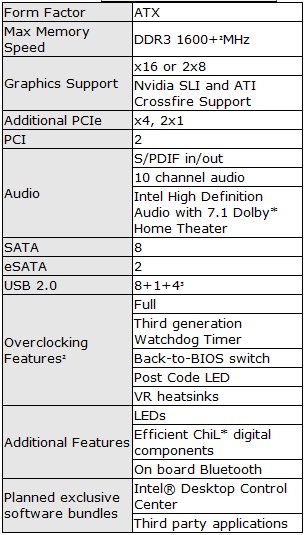
Naively supporting DDR 3 Dual Channel 1333 we can assure you we’ve had ram on the board overclocked to 2 GHz with very little effort so if you want to use really high speed, all you’ll need is a little overclocking and your good to go.
All of the boards we’ve seen thus far are limited to one full 16x PCI-E slot and if you run SLI they change to 8x8x and if you run 3 GPU’s they will run in 8x8x4x. We expect to see enthusiast variants with more PCI-E lanes in the near future but with the new chipset designs we can’t make any promises.
Intel has carried over the Skull emblem from previous Extreme boards and on this board the Skull is lit with a series of LEDs.
This is the bundle we got with our board, rest assured the retail bundle will be fluffed out. We received an I/O plate, Bluetooth Antenna, and an SLI Bridge.
Then we have the beasty board itself. Notice Intel dropped the legacy floppy controller and IDE controller. All we can say is it’s about time enthusiast boards drop the legacy ports. Let’s take a look at the chipset block diagram before we get into any more drool shots.
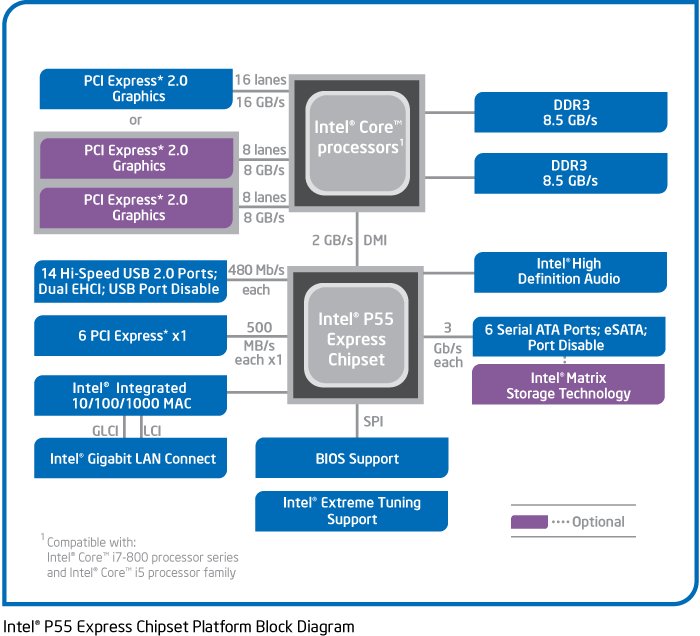
The P55 chipset has 22 lanes for PCI-E and as you can see, the CPU itself handles 16 of those lanes. Having the processor handle the PCI-E lanes will reduce latency and improve PCI-E performance. The Memory controller is integrated into the CPU and it’s designed for Dual Channel DDR3. Right below the CPU (in the diagram) is the PCH or Platform Controller Hub. It controls the USB ports, 6 PCI-E Express lanes, integrated LAN controller, Intel High Definition Audio, 6 Serial ATA ports, and optionally Intel Matrix Storage. It also provides BIOS support and Intel Extreme tuning.
In the not to distant future you can expect a lot of these functions to be moved onto the CPU itself, this is just the first shot at moving more functions on DIE and as CPU technology advances more functions will be assigned directly to the CPU.
The Layout diagram can be enlarged by clicking the picture. The Intel Extreme board supports all current LGA 1156 CPU’s and sports the spanking new two chip design P55 chipset. Officially supports Dual Channel DDR3 1333 and 1600 by OC. We’ve had ram past 2GHz so take that for what it’s worth. Like we mentioned earlier, you get one full PCI-E 16x slot that when split to two GPU’s goes to 8x8x, one PCI-E 4x, two PCI-E 1x and two PCI.
There are 8 SATA ports, 6 of which are controlled by the CPU and two by a separate chip. We had been hoping to see SATA 6GB/s ports this generation, but apparently it’s still on the drawing board. Intel Matrix Storage is supported on this board. HTPC people are covered by USB remotes and they included an infrared port on the board.
The Mosfets are of course heatsinked and the 6 phase power regulators get a nice heatsink as well. One of the unexpected features we found is the Bluetooth adapter but with Bluetooth becoming more accepted we are glad to see the inclusion.
They thoughtfully included a Post Code Led display to help debug any problems you might have with your build. Should you have any overclocking accidents, they put a ” Back to BIOS ” button on the I/O plate that will return you to the last working BIOS settings. We’ll leave the ports on the I/O plate for a little later.
Intel included Dolby home theater with 10 channel high definition audio, which is pretty upscale for onboard audio. The board is Lead free and sports a normal ATX form factor.
For those that would like more in depth information on the Intel DP55KG Extreme, we’ve included a technical specifications JPG that can be enlarged for easy reading.
Motherboard Continued
Here’s a look at the 8 SATA 3GB/s ports and we take notice that more vendors are listening and they are all 90 degree ports. Notice the silk screened skull to the left, it’s lit up with a series of LED’s.
The front panel I/O connector has moved up by the motherboard power connector and sadly we see some electrolyte capacitors. Most vendors have moved to the longer lasting solid capacitors.
Under the heatsink you’ll find the PCH, Platform Controller Hub and we are thinking it must run cooler because that’s not much of a heatsink. It didn’t seem to affect performance during overclocking but we’ll have to wait on other model boards to be sure.
The PCI-E slot arrangement is a little unusual, the first slot is a full length full speed 16x slot, then you get 2 PCI-E 1x, followed by a 8x slot with a full length clip for GPU’s, next to that is a PCI slot, then a PCI-E 4x slot with the same full length clip, and another PCI slot.
Tucked away in the corner is a onboard power switch which we always like to see.
Notice how close the CPU socket is to the ram banks, we have a Thermalright Mux 120 which is skinnier than the TRUE 120 we use on the LGA 1366 platform and the Mux overhangs the first ram slot so you’ll need to watch cooler size on this board.
We don’t have a manual for the board but that looks like an onboard USB port for Turbo Boost USB memory.
Here’s a close up of the Post diagnostic LED readout panel, it’s in a little bit of an odd spot but you should be able to see it.
The Back panel has no PS2 type ports so your going to need a USB keyboard and Mouse, Left to right you have 2 eSATA ports, the ” Back To BIOS ” button, Optical SPDIF IN and Out, 4 USB ports, two USB and a 1394 Firewire port, two USB and a Gigabit Lan, and the normal audio ports.
While the legacy IDE is missing the solder points for it are still evident on the board.
Then we’ll leave the motherboard section with a shot of the Extreme Skull grinning at us.
Stock Intel Cooler
Here’s the stock Intel cooler, most of you have seen them before so we are not going into great detail on it.
Here’s a look at the fin design and that mysterious thermal compound we always replace with Artic Silver.
Then here’s a full bottom shot of the stock cooler, for most people the stock cooler does it’s job but if you are overclocking at all, consider the Thermalright Mux 120 pictured below. (or similar high end cooler)
Thermalright Mux 120 CPU Cooler
We’ll tell you right up front we have no specifications or information on the Thermalright Mux 120 what so ever. All we have is pictures and hands on performance.
We think Thermalright has the right idea, who really cares about a flashy box as long as the product inside is top notch.
The Thermalright Mux 120 is another of the typical Thermalright tower designs and looks similar to the TRUE 120 series.
The Mux 120 is a little thinner than the TRUE 120 and only sports 4 heat pipes but we’ve seen this cooler hold massive overclocks to tolerable temperatures.
Seen from the side you get a good look at the 4 heat pipes.
They included a decent TR1212PSI fan with the Mux 120 but it would have been nice if the cable was sleeved.
You get a tube of the latest Thermalright Chill Factor, the fan mounting wires (if Thermalright is reading this please come up with an easier mounting system like the True 120 RT). Then we were shocked and dismayed to see an Intel style mounting system and the lack of a back plate. We make no bones about it, the Intel mounting system works but we just don’t like it at all. We’d rather remove the motherboard and put a back plate on the motherboard than have to fool with the Intel mounting system. If you mount coolers as often as we do, you would understand that the chance of one of the legs popping off and letting the CPU overheat and shut down the system is just to great. Put a back plate on this one and call it good. The performance was great, the fan mounting system and CPU hold down, not so great. If we were rating this one we’d have to split the rating to 9 for performance, and 6 for hardware.
Then the shot everyone wants to see on CPU coolers, the base on the Mux 120 is nice and flat and highly polished.
Testing & Methodology
We did a fresh load of Vista Ultimate 64 bit on the Crucial 128GB SSD and loaded all the latest motherboard drivers for the Intel Extreme board. We updated the BIOS to the newest available BIOS at the time of testing. We ran each test 3 times and report the average of each three pass run here.
We’ve added several new CPU benches and while we didn’t have the time to go back and bench all the CPU’s we’ve tested, we did go back and test the i7 965 and Phenom 2 X4 965 so we would have comparison numbers. At the bottom of the page you will find the new benches listed.
Test Rig
| Test Rig “Quadzilla i5” |
|
| Case Type | Sunbeam 9 Bay Acrylic Chassis |
| CPU | Core i7 870 Core i7 750 |
| Motherboard | Intel Extreme DP55KG |
| RAM | Kingston HyperX DC DDR3 1600 4 GB Kit Cas 8 |
| CPU Cooler | Thermalright Mux 120 (Dual 120mm Fans) |
| Hard Drives | Crucial 128 GB SSD(MLC/Samsung controller) |
| Optical | Sony DVD R/W |
| GPU(s) | BFG GTX-260 Maxcore |
| Case Fans | 120mm Fan cooling the mosfet CPU area |
| Docking Stations | None |
| Testing PSU | Tagan BZ 700w Modular |
| Legacy | None |
| Mouse | Razer Lachesis |
| Keyboard | Razer Lycosa |
| Gaming Ear Buds |
Razer Moray |
| Speakers | None |
| Any Attempt Copy This System Configuration May Lead to Bankruptcy |
|
Test Suite
|
Benchmarks |
|
Excel 2007 |
|
Blender |
|
SiSoft SANDRA XII Professional SP2 |
|
Everest Ultimate Edition v. 5.0 |
|
AutoMKV |
|
Cinebench R10 64 bit |
|
WinRar v. 3.71 |
|
POVRay |
|
Pro Show Gold |
Like we mentioned we ran each test 3 times on each CPU then averaged the results, the average is reported here. Some tests we ran more than 3 times and in that case we averaged all the results. If we happened to get a seriously out of range result we discarded to anomalous result and repeated the test.
We kept most of the Synthetic Benchmarks but added a lot of real life benchmarks. This is a trend you will see a lot more of at Bjorn3D. For Winrar we added a workload test consisting of compressing 5 large images, Pro Show Gold we encode a video file, Excel we run calculations on two large spreadsheets, Blender we render a wire frame photo, and AutoMKV we encode another large video file. While synthetic benches are good, real life testing with heavily multi-threaded applications that take advantage of more than 2 cores is long overdue. These applications are heavily multi-threaded and well coded to take advantage of the quads.
Everest Ultimate

“EVEREST Ultimate Edition is an industry leading system diagnostics and benchmarking solution for enthusiasts PC users, based on the award-winning EVEREST Technology. During system optimizations and tweaking it provides essential system and overclock information, advanced hardware monitoring and diagnostics capabilities to check the effects of the applied settings. CPU, FPU and memory benchmarks are available to measure the actual system performance and compare it to previous states or other systems. Furthermore, complete software, operating system and security information makes EVEREST Ultimate Edition a comprehensive system diagnostics tool that offers a total of 100 pages of information about your PC.”
CPU AES
This integer benchmark measures CPU performance using AES (a.k.a. Rijndael) data encryption. It utilizes Vincent Rijmen, Antoon Bosselaers and Paulo Barreto’s public domain C code in ECB mode.
CPU AES test uses only the basic x86 instructions, the test consumes 48 MB memory, and it is Hyper Threading, multi-processor (SMP) and multi-core (CMP) aware.
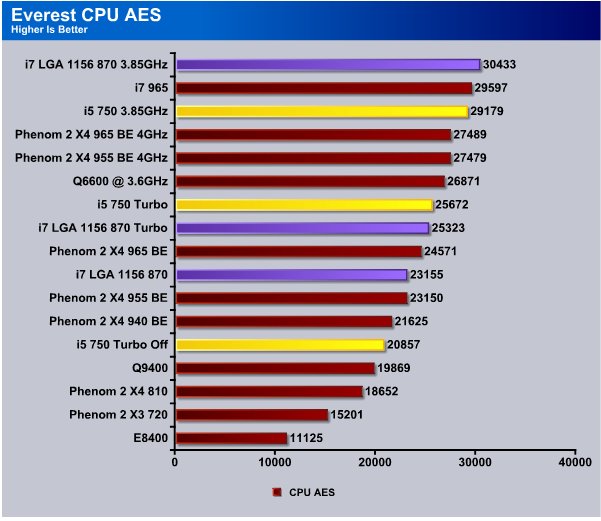
The thing to keep in mind on most of the charts is that the other CPU’s are running at stock speed unless we put a speed to the right of the CPU’s name. You can easily look at the CPU AES chart and think that the i7 870 is faster than the i7 965. The I7 870 is overclocked to 3.85GHz, and the i7 965 is cruising along at 3.2 GHz. If we tried to depict every CPU at the best OC the charts would become too confusing. However, if you care to dig up any of the CPU reviews you will find the best OC numbers for the CPU in it’s initial review.
We benched each new CPU three ways, at 3.85GHz to show a clock for clock comparison, with Turbo Boost on to show out of the box performance, and with Turbo off to show how much of a performance increase you get with Turbo Boost turned on. Believe us, if you are not overclocking leave Turbo Boost turned on.
Overclocked we see the i7 870 outstripping the i7 965 at stock speed, however when we drop back to the Turbo setting on the i5 750 and i7 870 we see that it comes in just ahead of the Phenom 2 X4 965 BE. With Turbo off the benchmark numbers fall dramatically.
CPU PhotoWorxx
This integer benchmark performs different common tasks used during digital photo processing.
It performs the following tasks on a very large RGB image:
• Fill
• Flip
• Rotate90R (rotate 90 degrees CW)
• Rotate90L (rotate 90 degrees CCW)
• Random (fill the image with random colored pixels)
• RGB2BW (color to black & white conversion)
• Difference
• Crop
This benchmark stresses the integer arithmetic and multiplication execution units of the CPU and also the memory subsystem.
CPU PhotoWorxx test uses only the basic x86 instructions, and it is Hyper Threading, multi-processor (SMP) and multi-core (CMP) aware.

In PhotoWorxx the overclocked i7 870 performed slightly better than the uber expensive i7 965, in Turbo mode both the i5 750 and i7 870 came in considerably slower than the i7 965. Again when we turned Turbo Boost off and ran at the native frequency of each CPU the benchmark numbers dropped.
CPU Queen
This simple integer benchmark focuses on the branch prediction capabilities and the misprediction penalties of the CPU. It finds the solutions for the classic “Queens problem” on a 10 by 10 sized chessboard.
CPU Queen test uses integer MMX, SSE2 and SSSE3 optimizations. It consumes less than 1 MB system memory and it is Hyper Threading, multi-processor (SMP) and multi-core (CMP) aware.
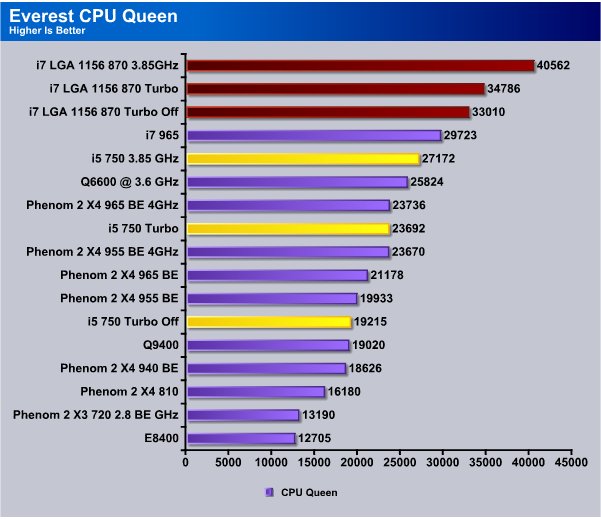
CPU Queen liked the i7 870 and it came out ahead of the i7 965 in every mode, the i5 750 came in just below the i7 965 when overclocked and dropped dramatically in Turbo and non-Turbo mode.
CPU ZLib
This integer benchmark measures combined CPU and memory subsystem performance through the public ZLib compression library Version 1.2.3 (http://www.zlib.net).
CPU ZLib test uses only the basic x86 instructions, and it is Hyper Threading, multi-processor (SMP) and multi-core (CMP) aware.
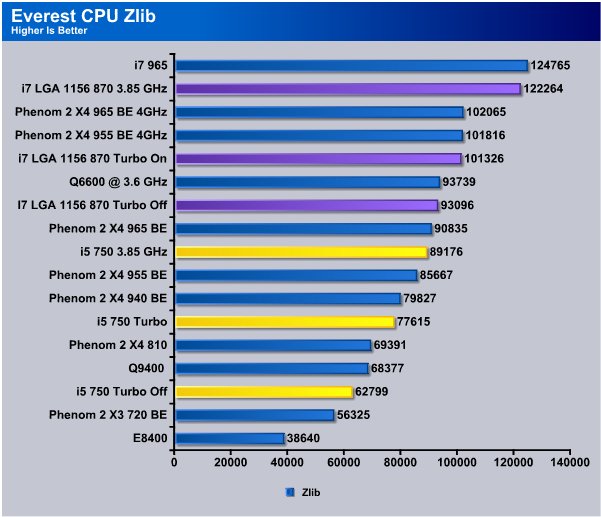
The i7 870 came in right behind the i7 965 but with Turbo on both CPU’s dropped considerably. Turbo is going to be good for non-overclockers but nothing beats a good overclock. Everest Zlib must have like the hyperthreaded nature of the i7 870 because the i5 750 didn’t fare nearly as well.
Everest Memory
The i7 1366 LGA package has the advantage of triple channel memory and it does the best in the Memory Copy test. Behind the i7 LGA 1366 it’s all LGA 1156 and core i5/i7 and Intel has made dramatic improvements in the dual channel DDR3 memory controller. The performance increase can also be partially attributed to the new two chip design and lower latencies it turns.
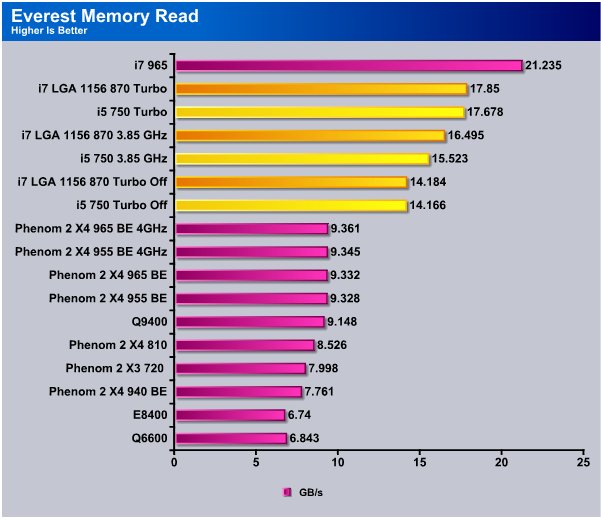
In the Memory Read test we see about the same thing going on, the Big Dog i7 LGA 1366 tops the charts then it’s LGA 1156 in the next six slots.
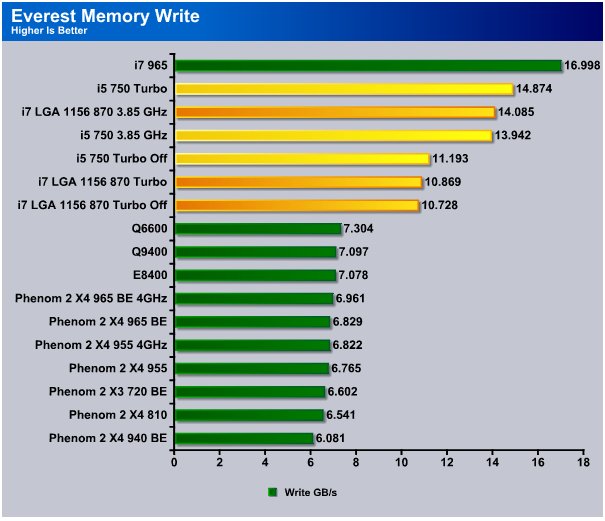
The Memory Write test confirms what we have been seeing in Everest so far, the LGA 1366 Triple Channel memory turns in higher numbers but the LGA 1156 Dual Channel DDR3 is turning in higher numbers than DDR3 Dual channel than we’ve seen on any previous platform utilizing Dual Channel DDR3. It seems that what we had suspected about DDR3 in previous reviews is true, it’s not the memory that was the problem, it was the hardware used to drive the memory.

The latency test in Everest shows us just how much the memory controller has improved. The highest latency we saw from either of the LGA 1156 CPU’s was 31.6ns running a high end kit of Patriot 2GHz ram, we were however running the kit at 1600MHz for the CPU reviews at 8-8-8-24 timings because we feel that the 1600 MHz range is going to be the typical speed most end users will buy.
Cinebench

“CINEBENCH is a real-world test suite that assesses your computer’s performance capabilities. MAXON CINEBENCH is based on MAXON’s award-winning animation software, CINEMA 4D, which is used extensively by studios and production houses worldwide for 3D content creation. MAXON software has been used in blockbuster movies such as Spider-Man, Star Wars, The Chronicles of Narnia and many more. MAXON CINEBENCH runs several tests on your computer to measure the performance of the main processor and the graphics card under real world circumstances. The benchmark application makes use of up to 16 CPUs or CPU cores and is available for Windows (32-bit and 64-Bit) and Macintosh (PPC and Intel-based). The resulting values among different operating systems are 100% comparable and therefore very useful with regard to purchasing decision-making. It can also be used as a marketing tool for hardware vendors or simply to compare hardware among colleagues or friends.”
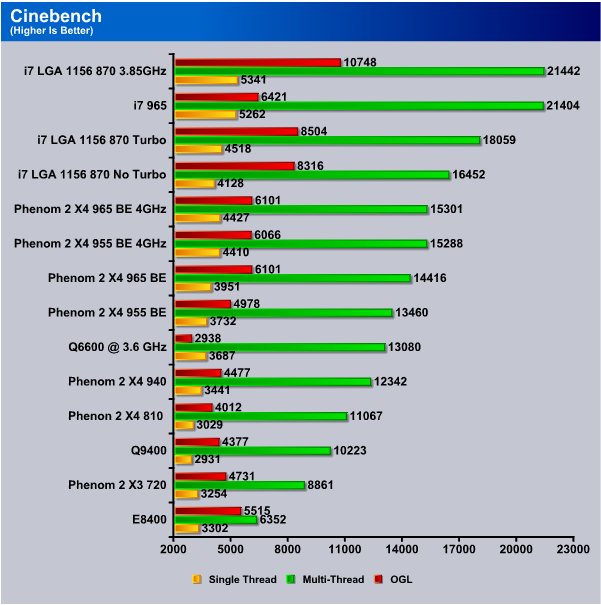
For some reason the i5 750 and Cinebench didn’t get along very well and Cinebench was reporting strange numbers. As soon as we get the problem fixed we’ll update the Cinebench chart.
Once again heavily overclocked the i7 870 topped the i7 965 running at stock speed, in Turbo mode we dropped about 3000 points and at stock speed with Turbo Off we dropped another 2000 points. I think we mentioned if you are not overclocking leave Turbo Boost enabled. Really with all the power savings features turned on, which is what you have been seeing in the charts with the CPU’s in Turbo Mode, we didn’t see any gains from turning off the power saving and thermal regulation modes. We left everything enabled in Turbo Mode just like BIOS defaulted to when we first booted the board. The only change we made to BIOS was to run the memory at as close to 1600 MHz as we could get.
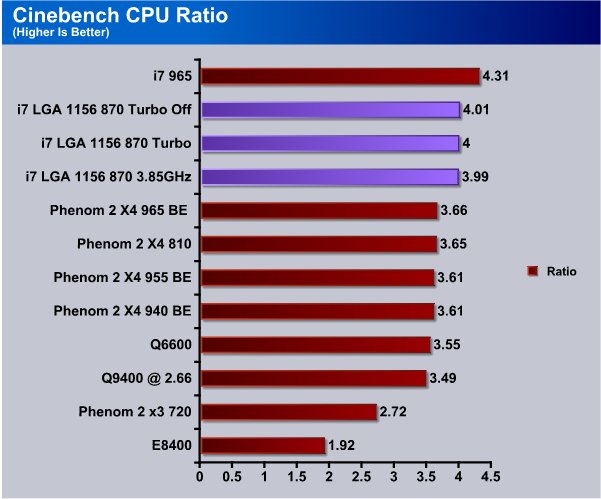
In Cinebench we didn’t get more than 4.01 for CPU ratio with the Hyperthreaded i7 870, previously on the i7 965 which is also Hyperthreaded we got 4.31 and i7 showed a better CPU ratio. This may be nothing more than an early BIOS we’ll have to wait and see.
WinRar v. 3.71

This module in WinRar generates random data, which contains specially introduced redundancy, increasing the load to both the processor and memory. Data is then passed through RAR compression and decompression algorithms, and the output of the decompression algorithm is compared to the source data. If any differences are found, WinRar then reports “Errors found – Yes” in the command window. WinRar displays a size of processed data and compression speed, current and resulting, in kilobytes per second.
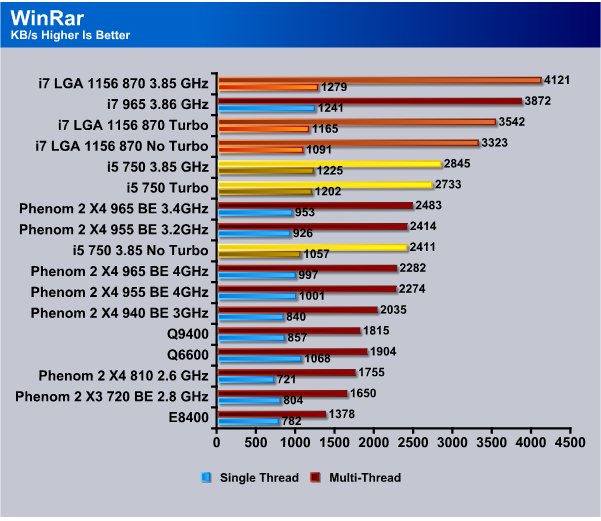
In Winrar which is more like a real life test than a benchmark we left the i7 965 3.85GHz results on the chart and interestingly enough the i7 870 beat it clock for clock. Additionally the i7 870 pretty much decimated the top end Phenom 2 X4 CPU’s but that can be expected in light of the expected $500+ price tag of the i7 870. The i5 750 in Turbo and overclocked outstripped the top end Phenom 2 X4 lineup and only dropped below the Phenoms when we manually set it to run at 2.66GHz with Turbo Boost turned off. It’s a little insane to turn off Turbo Boost if your not overclocking but we had to make sure Turbo Boost was actually providing the performance increase it should.
Winrar Workload
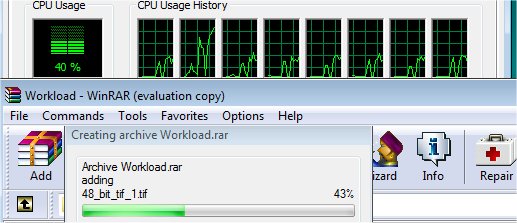
The Winrar workload test we bypass the built in benchmark and throw 5 large .tif images at Winrar then compress them and record the compression time. Total workload is about 350MB or 70+ MB per TIF image. The real life compression test of a group of large image files should give us a more realistic idea of how the CPU’s perform than the built in benchmark.
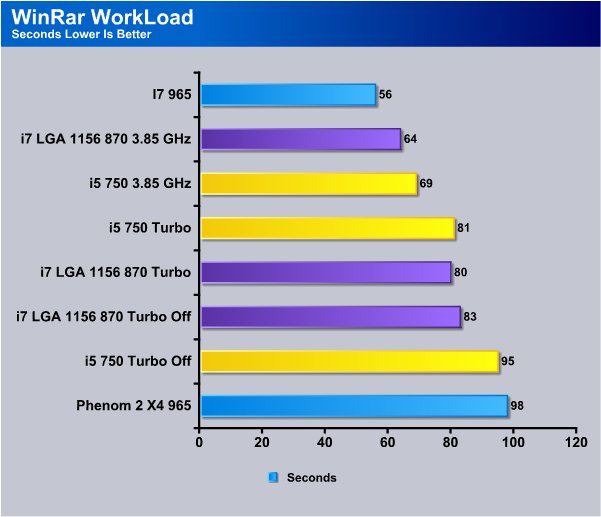
The Winrar workload test is new for Bjorn, and we had time to go back and get the results from the i7 965 and the Phenom 2 X4 965. As we review more CPU’s we’ll add those to the chart. The i7 965 again comes in on top the chart keeping it’s Big Dog mantle followed by the overclocked I7 870. Behind the i7 870 we see the overclocked i5 750 and the i5 750 in Turbo mode. The the new CPU’s held to their stock clocks with no Turbo followed by the Phenom 2 X4 965 dragging the back of the pack.
Sisoft Sandra
“SiSoftware Sandra (the System ANalyser, Diagnostic and Reporting Assistant) is an information & diagnostic utility. It should provide most of the information (including undocumented) you need to know about your hardware, software and other devices whether hardware or software. It works along the lines of other Windows utilities, however it tries to go beyond them and show you more of what’s really going on. Giving the user the ability to draw comparisons at both a high and low-level. You can get information about the CPU, chipset, video adapter, ports, printers, sound card, memory, network, Windows internals, AGP, PCI, PCI-X, PCIe (PCI Express), database, USB, USB2, 1394/Firewire, etc.”
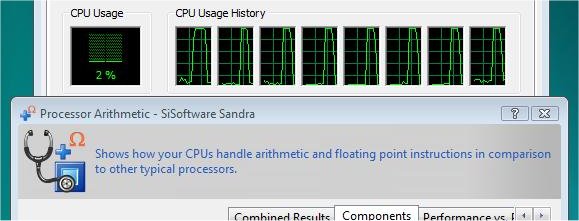
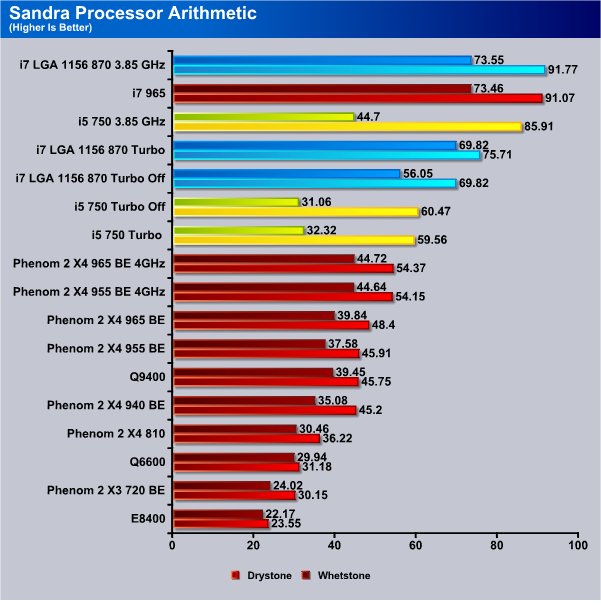
The Sandra CPU Arithmetic test shows the overclocked i7 870 topping the stock speed I7 965, given an equal overclock you know the i7 965 would be setting pretty on top the chart. Even overclocked to 3.85 GHz the i5 750 can’t top the stock speed i7 965 and the much lower Whetstone test is a little surprising on the i5 750. We’re going to have to investigate that lower score when we have more time. Taking an overall look at the chart LGA 1366 and LGA 1156 are in the top 7 slots which should tell you a lot about it LGA 1366 and 1156 platforms.
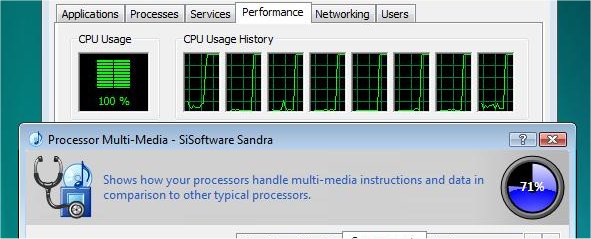
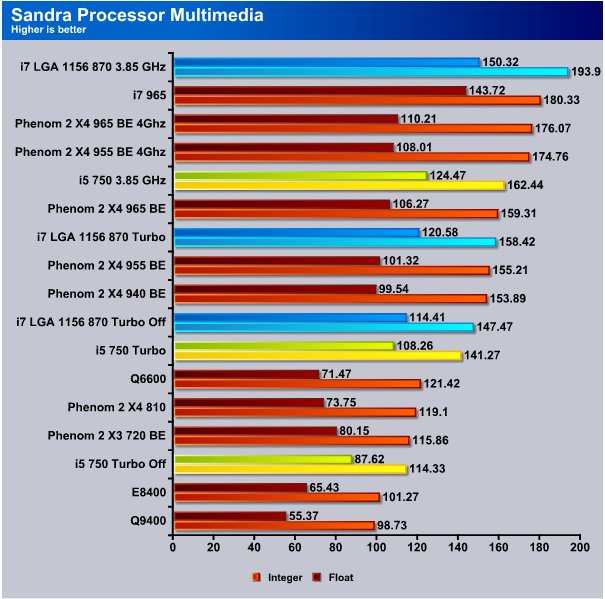
The Multimedia test had the CPU’s all over the charts so much that we repeated the test 6 times for each CPU and averaged that result. the overclocked i7 870 topped the chart with great scores followed by the stock clocked i7 965. After the i7 870 and i7 965 we see the heavily overclocked Phenom 2 X4’s making a good show in Multimedia, then the i5 750 overclocked. Interestingly enough the i7 870 falls below the Phenom 2 X4 965 when the i7 870 is in turbo mode. The higher native clock speed of the Phenom and the heavy AMD optimization for multimedia applications explain that. The i5 750 maximum Turbo is 3.2 GHz and it falls right below the i7 870 when the 870 has Turbo turned off. The i5 750 falling below the i7 870 is probably due to the heavily multi-threaded nature of the Multimedia teat and shows the advantage of the Hyperthreaded nature of the i7 870.
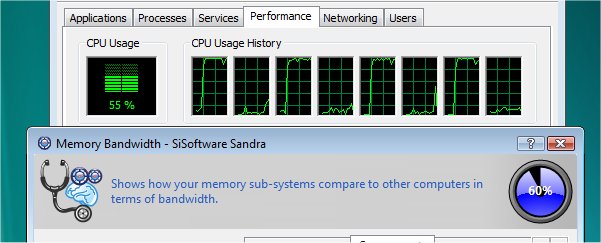

The Sandra Buffered Memory test shows us the same standings as Everest did, the i7 965 tops the chart with it’s Triple Channel DDR3 advantage, and the next six slots fall to the LGA 1156 platform. The i7 870 shows some performance gain when overclocked but beyond that the LGA 1156 platform turns in numbers so close together that it would be a hard call. That’s to be expected the Memory bandwidth test in Sandra uses 4 cores and Hyperthreading doesn’t factor into the equation. Other than being threaded for four cores both the i5 750 and i7 870 have identical memory controllers so close scores are expected. Most of the differences here are the different ram speeds that occur due to overclocking and using dividers to keep the speeds close to 1600 MHz.
POV-Ray 3.7 Beta 25

The Persistence of Vision Ray-Tracer was developed from DKBTrace 2.12 (written by David K. Buck and Aaron A. Collins) by a bunch of people (called the POV-Team) in their spare time. It is a high-quality, totally free tool for creating stunning three-dimensional graphics. It is available in official versions for Windows, Mac OS/Mac OS X and i86 Linux. The POV-Ray package includes detailed instructions on using the ray-tracer and creating scenes. Many stunning scenes are included with POV-Ray so you can start creating images immediately when you get the package. These scenes can be modified so you do not have to start from scratch. In addition to the pre-defined scenes, a large library of pre-defined shapes and materials is provided. You can include these shapes and materials in your own scenes by just including the library file name at the top of your scene file, and by using the shape or material name in your scene. Since this is free software feel free to download this version and try it out on your own.
Some of you might have seen version 3.6 of POV-Ray, the biggest difference between 3.6 and 3.7 Beta 25 is SMP (symmetric multiprocessing) support, which means that POVRay can take advantage of as many cores as your CPU has. On Single vs Dual CPU systems the speed almost doubles.
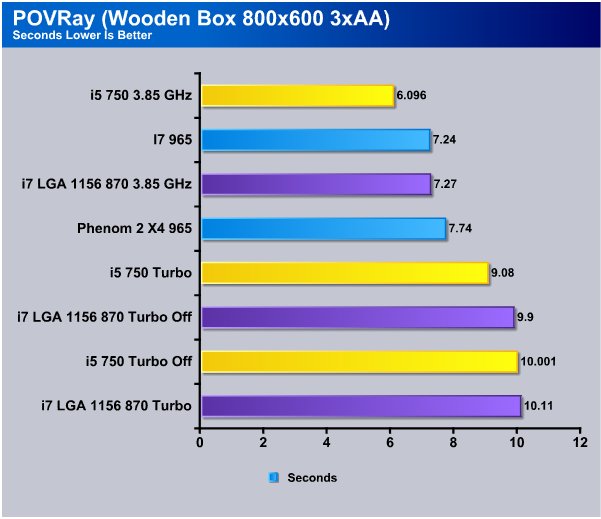
We mentioned SMP in our benchmark description but we aren’t sure just how good that SMP support is for hyperthreaded CPU’s. From the other tests we’ve seen by all accounts the i7 870 overclocked should be sitting on top the chart if it handled Hyperthreaded CPU’s well. That’s not what we are seeing here, the i5 750 which is a straight 4 core non-Hyperthreaded CPU topped the chart when overclocked, followed by the i7 965, then the i7 870 and in fourth place we see the Phenom 2 X4 965. Things get even stranger when the i7 870 with Turbo turned off beats itself with Turbo Turned on. The maximum speed of the i7 870 in Turbo is 3.6Ghz (single core) and 3.2GHz (4 core) so POV-Ray utilizing all the cores Hyperthreaded, why did the i7 870 in Turbo mode flop to the bottom of the chart? We can’t say at this point but it bears investigation.
Microsoft Excel 2007
Monte Carlo Black-Scholes Option Pricing Test
Microsoft Excel is the widely known and most used spreadsheet application for the manipulation and calculation for number crunching. With Excel you can analyze and share information on small scale or the largest scale you can imagine. We’ve seen spreadsheets in every day use that contain literally tens of thousands of numbers and hundreds of equations. Bjorn3D uses two tests in Excel to determine CPU and Motherboard performance.

This workload calculates the European Put and Call option valuation for Black-Scholes option pricing using Monte Carlo simulation. It simulates the calculations performed when a spreadsheet with input parameters is updated and must recalculate the option valuation. In this scenario we execute approximately 300,000 iterations of Monte Carlo simulation. In addition, the workload uses Excel lookup functions to compare the put price from the model with the historical market price for 50,000 rows to understand the convergence. The input file is a 70.1 MB spreadsheet.
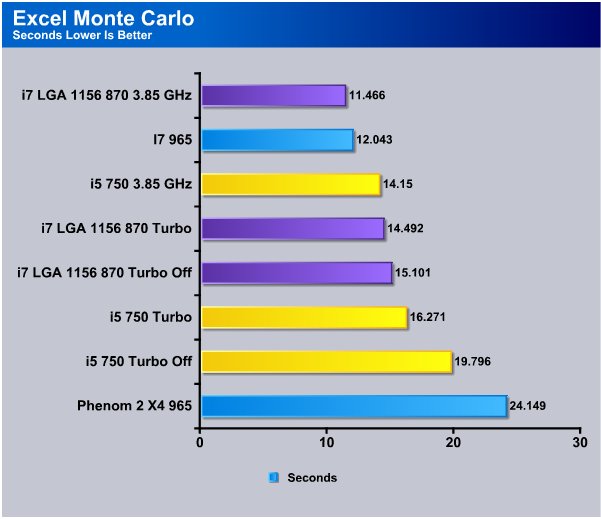
In the Excel Monte Carlo Black Scholes Option Pricing test we see the i7 870 overclocked to 3.85GHz riding the top of the chart with an amazing 11.466 second score, followed by the i7 965 which ran in just a hair over 12 seconds. The i5 750 calculated the massive spreadsheet in just over 14 seconds and the i7 870 in Turbo mode ran the calculations is just under 14.5 seconds. The i7 870 with turbo off came in around 15.1 seconds and the i5 750 in Turbo Mode came in at 16.27 seconds. Turn Turbo off on the i5 750 and we lose more than 3.5 seconds. Rounding up the pack is the Phenom 2 X4 965 sitting in dead last.
Big Number Crunch
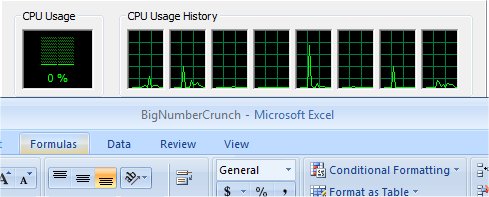
This workload is from a 6.2 MB spreadsheet and executes about 28,000 sets of calculations. It uses the most common calculations in Excel, addition, subtraction, division, rounding and Square Root. It also analyzes statistical functions such as Min, Max Median, and Average. The calculations are done after the spreadsheet with a large data set is updated with new values and must recalculate a large number of data points.
We feel the addition of Excel to our real life benchmarks is an important one. Excel has a huge user base and is one of the most widely used applications worldwide. While Excel will run on almost and modern machine it’s the CPU performance that will determine how fast it runs making it a good application for judging CPU and Motherboard performance.
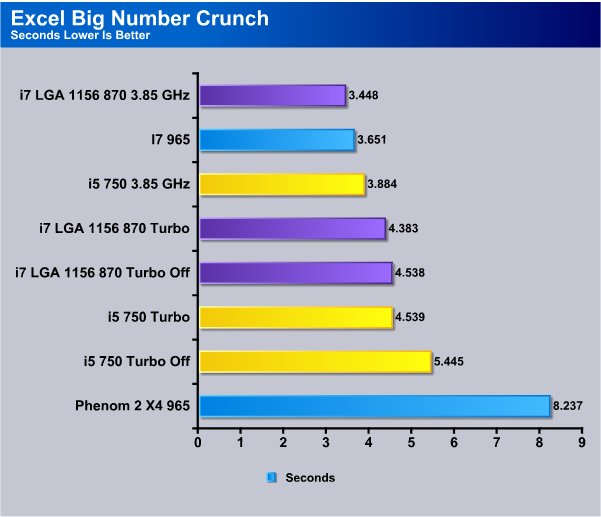
The Overclocked i7 870 running at 3.85 GHz topped the i7 965 at stock speed. The I5 750 came in right below the i7 965 followed by the i7 870 in Turbo mode, once again the 870 with Turbo off came in right behind the 870 with Turbo turned on. The i5 750 with Turbo on came in just ahead of itself with Turbo off, and dragging last place is the Phenom 2 X4 965 which has bottomed out many of the charts. With the i5 750 in the same price range as the Phenom 2 X4 series and sporting a 95w TDP AMD could be in trouble with this one. We suspect that the cross platform capabilities of the AMD CPU’s with the easy upgrade path will keep them from taking to large a hit though.
Photodex ProShow Gold 3.2
ProShow Gold allows you to combine videos and photos and music to create slide shows, depending on the end user results can be spectacular. The application allows the end user to share photos and memories with friends in a unique and spectacular way, the different formats supported are, DVD, PC and Web. Still Photos are brought to life by adding motion effects. Supported effects include, Pan, Zoom, and rotate. You can also add captions and over 280 transition effects.

The workload we use consists of 29 high resolution images in JPG format and converts them to MPEG2 widescreen DVD quality. The end result is a 3 minute 9 second video file in slideshow format. The images are in 3872×2592 resolution and have a combined total size of about 170 MB.
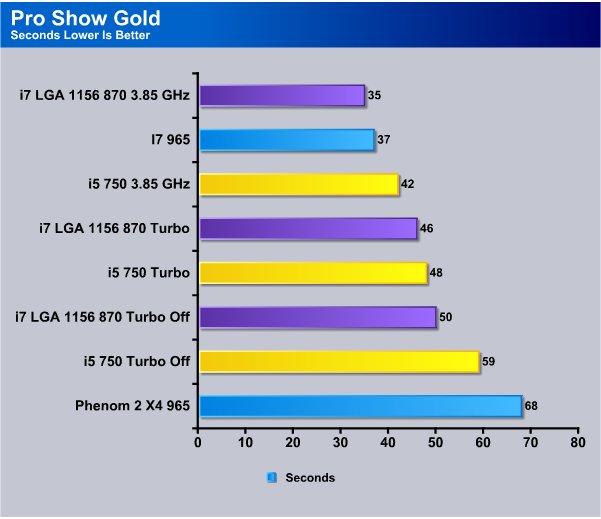
We spent a lot of time with ProShow Gold before adding it to our benchmarks, checking the image above, and seeing that it’s driving a 4 core hyperthreaded CPU for all it’s worth should tell you why it made the cut.
The i7 870 running at 3.85 GHz topped the chart, followed by the stock clocked i7 965 and the overclocked i5 750 followed the 965. True to form the i7 870 in turbo mode came in right ahead of the i5 750 in Turbo, and both CPU’s in Turbo mode topped the non-Turbo i5/i7 CPU’s. If we haven’t convinced you by now let us reiterate, if you are in the non-overclocking crowd leave Turbo Boost enabled, it’s very well behaved and provides a real performance boost. If your a hard core overclocker go for the gusto, but you’ll have to make a nice OC to beat Turbo Mode. Remember the Single core Turbo speed of the i7 870 is 3.6 GHz and the i7 750 you won’t need as large an OC but it Turbo’s to 3.2 GHz which is a 534MHz performance increase from stock. We’re still getting used to self overclocking CPU’s but Intel has done a great job with that feature.
AutoMKV 0.95c
AutoMKV is an application aiming for easy media conversion between various media formats using various third party codecs. With improved internet speed and enhanced computing power, more users are interested in encoding to different media formats for their various multimedia needs. With AutoMKV and x264 codec, a freeware H.264 encoder, users can easily create media files. For more information and to obtain AutoMKV 0.95c and AviSynth* 2.5.7, please visit (http://forum.doom9.org/showthread.php?t=134478). We create a media file using AutoMKV and x264 codec. The input file used in the document is a raw 416 MB 720×480 DV file and the output is a 253MB H.264 media file.
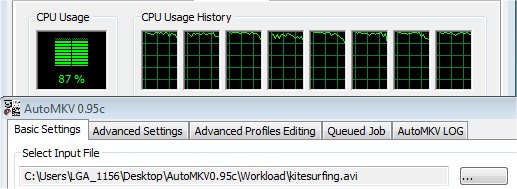
Looking at the Task manager with AutoMKV driving all 8 cores is a good indication that it’s great for evaluating multi-core CPU’s. Most of the encoding we saw drove the CPU’s at or close to 100%. We just got unlucky and hit Print Screen at an inopportune moment.

With times ranging between 3.07 Minutes (i7 965) all the way up to 11.34 Minutes (Phenom 2 X4 965) you can see how well AutoMKV scales across CPU’s. The i7 965 tops the chart with an astounding 3.07 Minutes, and what’s more amazing is that a processor that costs half as much, the i7 870 is .05 minutes from matching it. Of course like we mentioned the 965 is running at 3.2 GHz (Stock Speed) and the i7 870 is heavily overclocked. AutoMKV is handling the hyperthreaded CPU’s very well and after the 965 the i7 870 took the next three slots. Following that the i7 750 took the next three slots. Dragging hind tail the Phenom 2 X4 965 with a whopping 11.34 Minutes.
Blender
Blender is a free open source 3D content creation suite that is available for various operating systems. The application is popular among many independent animation studios and game makers. For more information, please visit http://www.blender.org/.
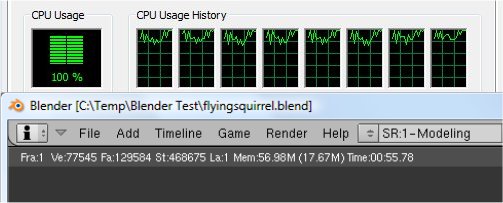
The workload consists of a ~6.9 MB character model of a flying squirrel. Due to time constraints we don’t render the entire image which would be time consuming and rather pointless except to yield larger benchmark numbers. A portion of the image, the right arm is what we render, it’s a large enough portion to show differences in CPU performance, yet small enough that we don’t have to grind through a 45 minute Render waiting for a single result.
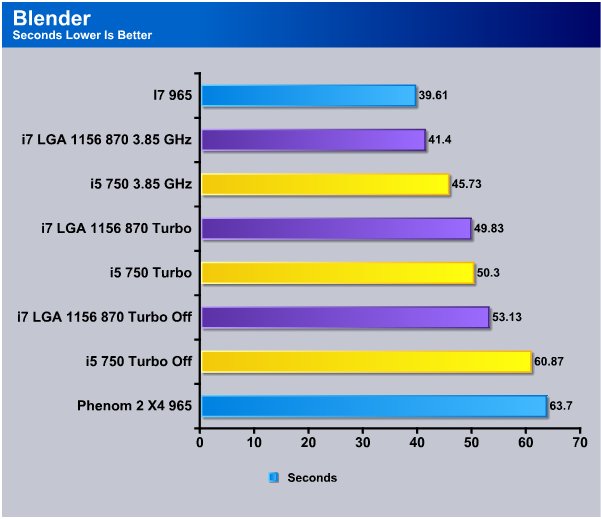
It’s going to take more testing with Blender before it becomes a regular in the benchmark suite but since we ran several hours of testing with it we thought we’d toss in the results because it is heavily multi-threaded.
The i7 965 turned in a 39.61 second render followed by the overclocked i7 870 and the i5 750 overclcok came in third. Then both the LGA 1156 CPU’s in Turbo Mode, followed by the LGA 1156 CPU’s in non-Turbo Mode. Dragging the bottom of the pack again was the Phenom 2 X4 965.
CPU-Z
CPU-Z is an adventure when screenshotting CPU’s with the power saving features turned on. It’s made infinitely more complicated when doing screenies of Turbo Boost CPU’s so bear with us for a few.
LGA 1156 i5 750

To get the stock speed shot we had to turn off Turbo Boost and set the BIOS for high performance forcing the rig to use the highest possible multiplier all the time. Default speed on the i5 750 is 2.66GHz and the top end multiplier is 20 which can go down to 9x but not above 20x. This is the non-Turbo mode we ran at and charted.
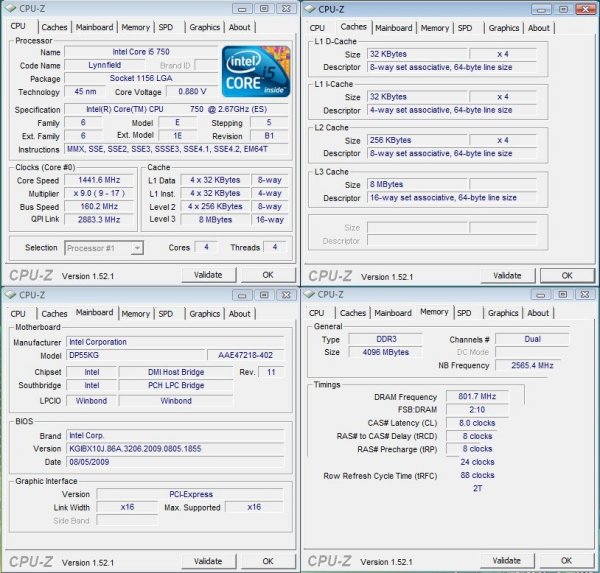
With Turbo on and all the power saving features enabled we see the CPU Multiplier dropped to 9x and the CPU voltage dropped to 0.880v resulting in a CPU speed of 1.44GHz and under load the CPU seamlessly jumps to 2.66GHz or above depending on Turbo Speed.
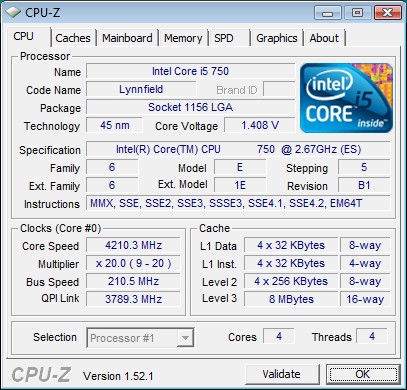
Best Stable OC we got on the Intel DP55KG board with the i5 750 was 4.2 GHz and it was the thermal limit that stopped us here. Safe running speed with the Thermalright Mux 120 was 3.85 GHz. Just how toasty did it get at 3.85 GHz?
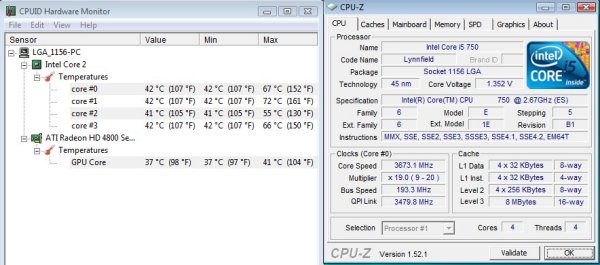
Notice the right hand column on CPUID Hardware Monitor, we hit 72° C on Core #1 and discovered that after a benchmark run that lasted about 5 minutes. By that time the CPU speed had dropped back to 3.67 GHz but we assure you we ran the bench full out at 3.85 GHz.
LGA 1156 i7 870
The same conditions apply for the i7 870 since it’s a Turbo Boost CPU we had to set it to 2.93 GHz manually in BIOS to keep the Turbo Boost and power saving features from affecting the pictured speed.

Again we turned off Turbo Boost and forced the CPU to run at the highest multiplier to get the stock speed shot. Stock speed is 2.93 GHz with a top end locked multiplier of 22x which should make it a little better overclocker than the i5 variant. It will of course let you decrease the multiplier and it will go to as low as 9x if you like.
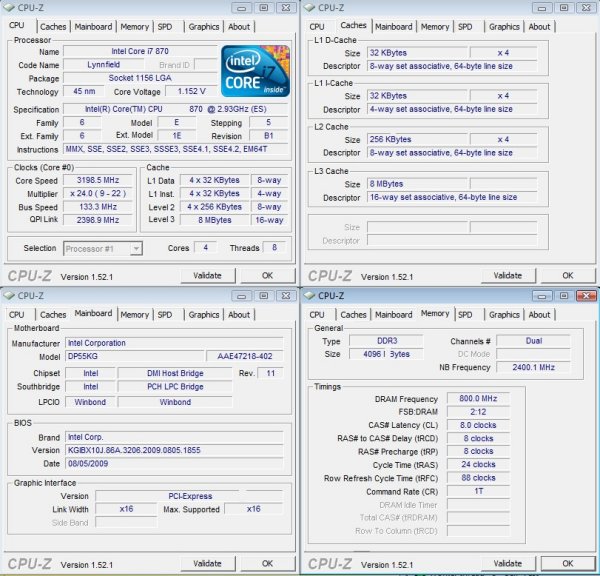
Notice that the top end multiplier is 22 when setting it manually, however this shot showing the CPU in Turbo Boost mode the system has increased the multiplier to 24 and the resulting 3.2 GHz speed. This was shot during a Prime 95 run with all the cores running, during single core operation the self overclocking Turbo Boost can hit as high as 3.6 GHz. Speaking of self overclocking to 3.6GHz take a look at the screen shot below.

CPUID TMonitor tells you the activity on all 4 cores and how fast they are running. Intel assures us they have tested TMonitor and it’s working correctly even though at the time of posting it was still in the Beta stage. We fired up Super PI and set the affinity to Core #0 ensuring single core operation and in so doing insuring the highest possible Turbo Speed which occurs during single core operation. You’ll have to squint a little to see it but we went past theoretical limits and hit 3.8 GHz or TMonitor isn’t quite as ready as suspected. If you notice the top speed on the scale on the left side of TMmonitor only goes to 3.666 GHz but the yellow bars go past that and in the top right hand corner it reads 3.8GHz. Like we mentioned the CPU has grown a multiplier of it’s own and hit 3.8 GHz Turbo or TMonitor needs a little tweaking.

We cranked up the volume and managed to hit 4.3 GHz and that was past safe thermal limits with the Thermalright Mux 120 so we benched at 3.85 which was pushing the top end thermal limits with the Mux 120. We did light stability testing at 4.3 GHz with Prime 95 and Super Pi and everything was nice and stable but we were way up there on the idle temp. How toasty was it on air? We hit 52° C idle, pretty toasty and we hadn’t even hit 1.45v on the CPU yet. With water cooling or phase change these will OC nicely. We saw one demo at a meeting in California with a phase change system and the i7 870 hit 5.5 GHz easily on Phase, that was at 1.7v so do so at your own risk.
CONCLUSION
There’s a lot to like about the LGA 1156 CPU lineup. Before we go any farther into the conclusion lets look at the expected price at the 1k distribution level.

With the i5 750 priced at $196 on a thousand CPU’s we can expect to see it surfacing around $229.99 so it’s going to be about $50 dollars cheaper than it’s LGA 1366 counterpart the i7 920 which E-tails for about $279.99. The i7 920 has been spotted at Frys on sale cheaper but this is the current lowest price we could find. We expect the platform LGA 1156 sits on to be less expensive than the LGA 1366 platform so price/performance wise it’s going to be very popular.
The i7-860 which we didn’t get to test runs at 2.8 GHz and unlike the i5 750 is Hyperthreaded. We like Hyperthreading and if it’s in your budget we would consider the i7 860 to be the sweet spot in the price performance range. The Hyperthreading will get you a little better performance than the i5 750 but we expect a lower multiplier than the i7 870 (21x) so it’ll take a little more Bclk to OC it as high.
The i7 870 runs at 2.93 GHz and sports a hefty price tag of $562 at the thousand level so we don’t expect everyone to snatch this one up. It’s a little expensive for most end users but performs great and overclocks like a champion. We understand Intel’s policy on enthusiast CPU’s and currently the LGA 1366 i7 975 and 965 are the only unlocked multipliers in their lineup. We would have liked to see an unlocked multiplier version of the LGA 1156 processors and that would have made the $600+ price tag a little more acceptable. Still if you can afford it the i7 870 is the current top dog in the LGA 1156 lineup and about half the cost of the i7 965/975 unlocked multiplier CPU’s so it might be a better option for uber enthusiasts price wise.
The Platform
We were swamped with LGA 1156 platform review requests prior to the launch so there will be a lot of hardware available for the i5/i7 CPU’s right out of the gate. Your current DDR3 ram will work but we highly recommend low voltage Dual Channel DDR3 because the LGA 1156 platform shares the 1.65v ram voltage limit with it’s big brother the LGA 1366 platform.
Overclocking the new two chip design platform was a sheer delight and we had speeds up to 4 GHz in just a few minutes. The NB/SB has been combined into one chip called the PCH so your dealing with less voltage options to balance. The new chipset will decrease latencies but currently limits the number of PCI-E lanes available for graphics. We expect to see variants from 3rd party vendors with more PCI-E lanes but that’s just an assumption.
The performance on the mainstream LGA 1156 i5/i7 CPU’s was higher than we expected and we are quite pleased with the price performance ratio. We would have been more impressed if Intel had released the Mainstream offerings first, then the enthusiast offering later. Once you’ve seen LGA 1366 you’ve seen nirvana, by the same token the LGA 1366 platform is a little pricey. The LGA 1156 platform promises to be a little more cost effective and that will be welcomed by a lot of end users.
Intel has done a fantastic job with the LGA 1156 CPU’s and vendor support is ready to go. It’s probably the most solid platform launch we’ve seen to date and they did it on a newly designed two chip chipset. Kudos Intel well done!
Rating i5 750 CPU
We’ve tried rating two products on the conclusion page in previous reviews and it just didn’t work out well so we split that into two ratings pages this time.
The i5 750 comes in at a much needed price point in the Intel lineup and performance was high. Overclocking the i5 750 we hit 4.2 GHz easily and it overclocked almost to easy. The i5 750 has a lot to offer for the non-overclocking crowd and Turbo Boost offers a nice performance enhancement with no end user intervention needed. We expect the bulk of the new platform users to adopt the i5 750 and with it’s performance you won’t hear any grumbling about the new CPU. Quite the contrary we expect rave reviews on it from end users.
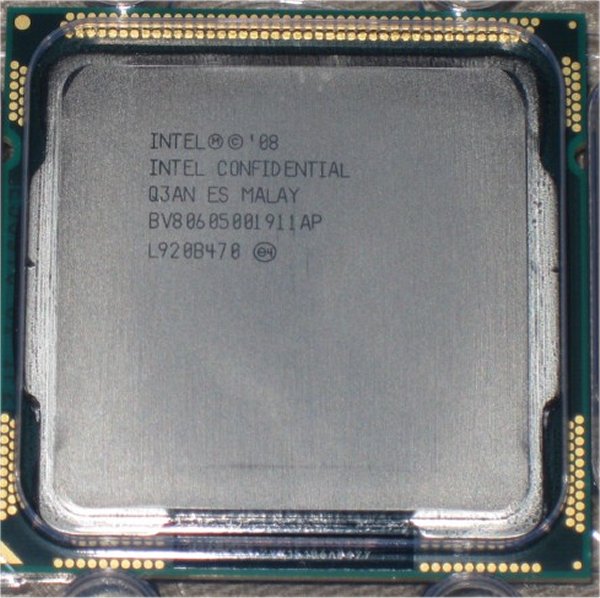
We are using an addition to our scoring system to provide additional feedback beyond a flat score. Please note that the final score isn’t an aggregate average of the new rating system.
- Performance 8
- Value 8
- Quality 10
- Warranty 8
- Features 9
- Innovation 8
Pros:
+ Champion Overclocker
+ Price Is Lower Then LGA 1366
+ 45nm Design/Lower Voltage Requirements
+ Performance Above It’s Price Point
+ Easy To Overclock
+ Newly Designed two Chip Chipset Is Solid As A Rock
Cons:
– Locked Multiplier
– Have To Have A New Motherboard To Support The LGA 1156 Chips
The Intel LGA 1156 Core i5 750 was a dream to overclock, performance was high, and considering it’s a new chipset design, it was amazingly well behaved. The chipset to drive it is well thought out and integrated a lot of the NB/SB functions into the PCH, other features have moved on to the CPU DIE which is a trend we expect to continue. Given it’s more mainstream price, overclocking ease and lower price the i5/i7 platform is a sure winner so it scores an: 8 out of 10 and the Bjorn3D Seal Of Approval.
Rating i7 870 CPU
We like the performance of the Intel Core i7 870 CPU, the Turbo Boost technology will offer a great performance boost for non-overclockers. We had the Chip up to 4 Ghz in just a few minutes and hit 4.3 GHz stable in under an hour. Thermal limits on air mandated we drop it to 3.85 GHz for testing but 4.3 GHz was nice and stable. Throw some extreme cooling on this puppy and mid 5GHz is not only doable we saw it run at 5.5 GHz with phase change cooling. We can’t wait to see what it will do on LN2 or Liquid Helium.
We realize that the bulk of CPU’s run on air cooling and we would say with good air cooling like the Thermalright Mux 120 3.85 GHz is sustainable at around 1.4125v.
The new chipset (P55) used to drive the LGA 1156 CPU’s sports a new 2 chip design and offers reduced latency and easier overclocking. Since the NB/SB has been combined into one PCH chip there’s less BIOS voltage to balance. The PCI-E x16 lane has moved onto the CPU DIE and that will affect graphics performance. Current boards only offer one full PCI-E 16x lane and that switches to 8x8x with two GPU’s. Variants from 3rd party vendors with more PCI-E lanes might be appearing soon, we can’t say for sure. We hope that variants with more PCI-E lanes are a short time away. With the new chipset and 16 PCI-E lanes on DIE it’s hard to say.
The price tag is a little higher than we expected on the i7 870 and that may put some end users off and drive them to cheaper CPU’s. To that end Intel has the i7 860 which runs at 2.8 GHz and with the overclocking capabilities of the i5/i7 LGA 1156 CPU’s we suspect that will be the enthusiast budget chip of choice.
We like the performance and overclockability of the i7 870. We didn’t expect it to perform as close to the i7 965 as it did and the i7 965/975 are still the Top Dog Intel CPU’s. With a hefty 1k+ price tag on the i7 965/975 we expect to see a lot more people adopt the more price friendly LGA 1156 i5/i7. We like the i5 750 CPU but we love the i7 870 because it’s hyperthreaded and that hyperthreading gives it a nice performance advantage.
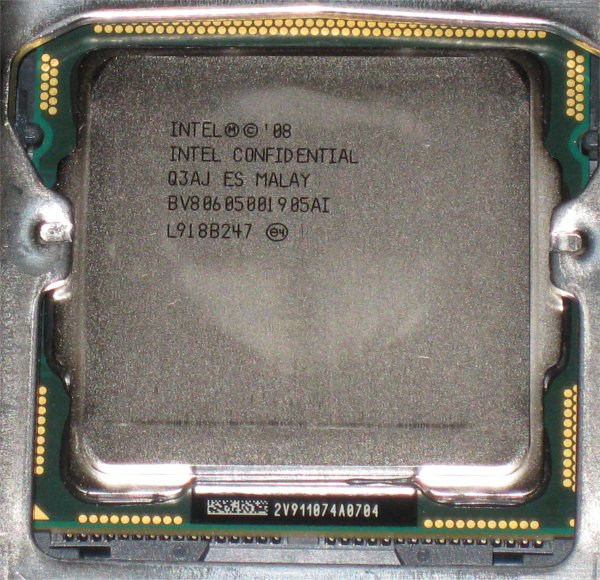
We are using an addition to our scoring system to provide additional feedback beyond a flat score. Please note that the final score isn’t an aggregate average of the new rating system.
- Performance 9
- Value 8
- Quality 10
- Warranty 8
- Features 9
- Innovation 9
Pros:
+ Turbo Boost Is A Boon To Non-overclockers
+ Overclocks Really Well
+ 45nm Design/Lower Voltage Requirements
+ New 2 Chip Design Platform
+ Easy To Overclock
+ Did we Mention 4.3 GHz on Air with Better Overclocking On More Extreme Cooling?
Cons:
– Locked Multiplier
– Little Pricey
The I7 870 is a champion overclocker and the new P55 chipset boards are capable of higher Bclk than the X58 platform. With A higher Bclk and the overclocking capabilities of the LGA 1156 CPU’s we are sure to see old CPU clocking records broken. The new P55 chipset is an easy to overclock rock solid platform with a lot of innovations we expect to see more of in the near future. The combination of the i7 870 and the P55 chipset makes the whole i5/i7 platform an innovative winner so the i7 870 scores an: 8.5 out of 10 and the Bjorn3D Seal Of Approval.
 Bjorn3D.com Bjorn3d.com – Satisfying Your Daily Tech Cravings Since 1996
Bjorn3D.com Bjorn3d.com – Satisfying Your Daily Tech Cravings Since 1996
